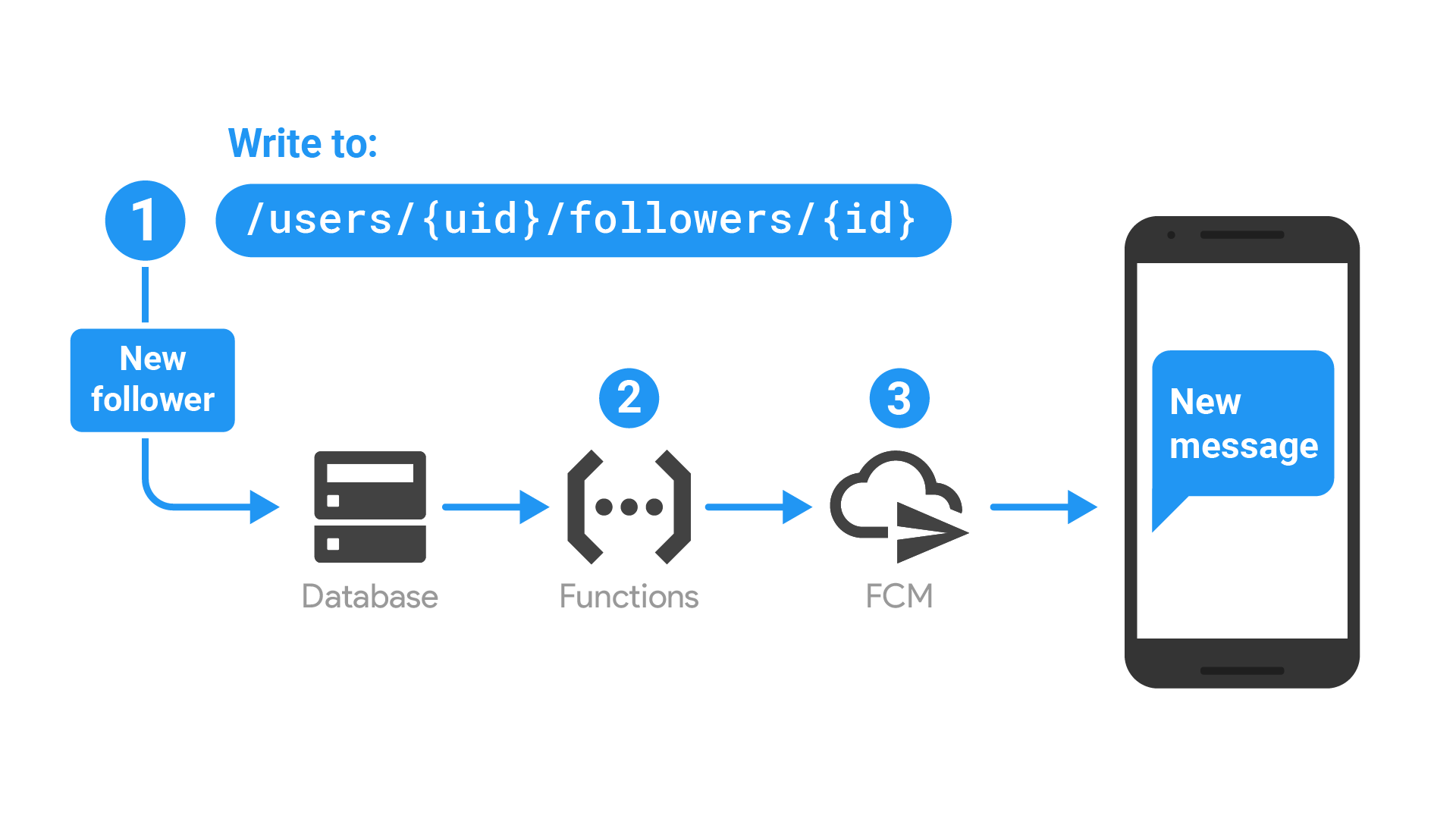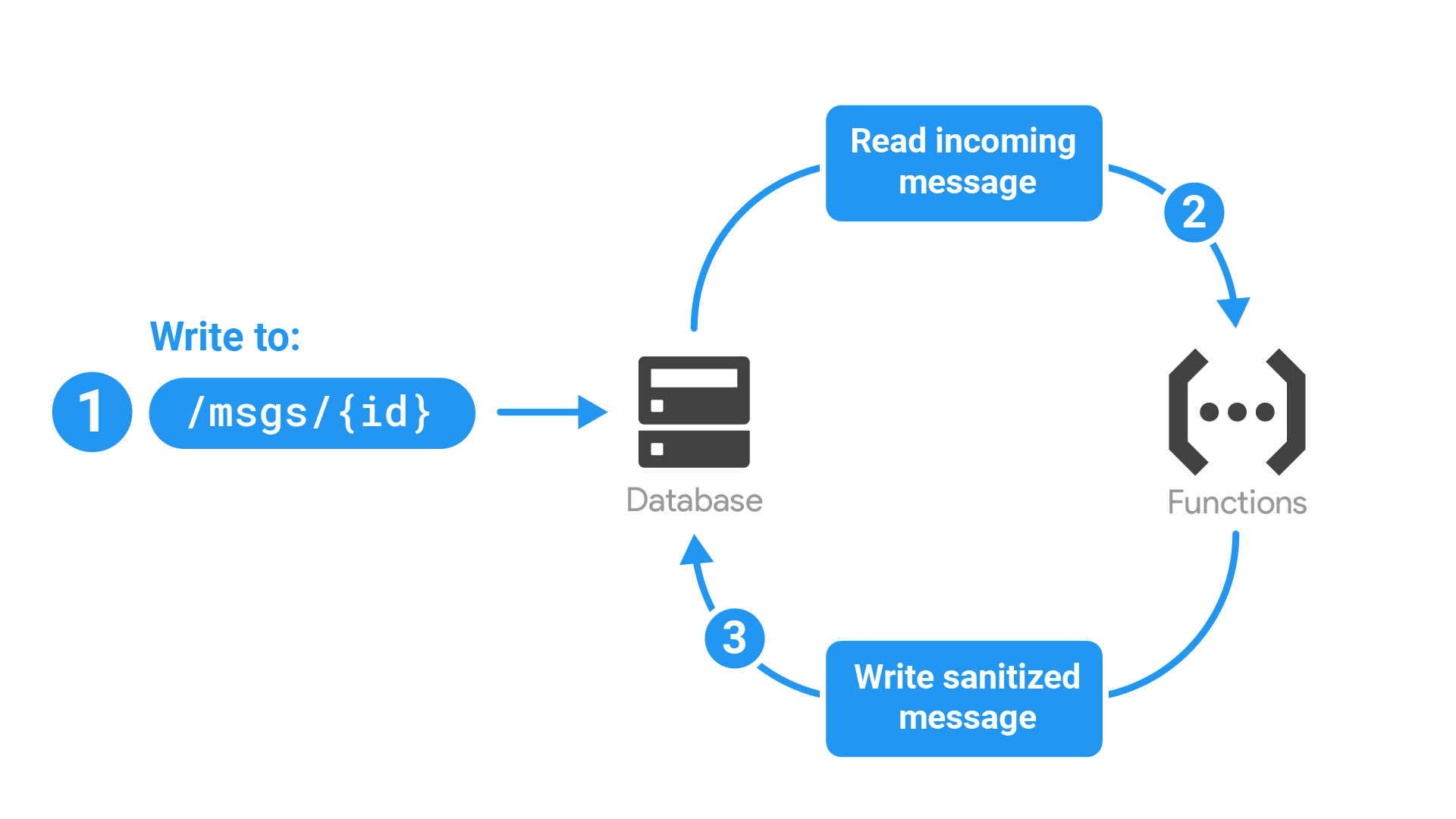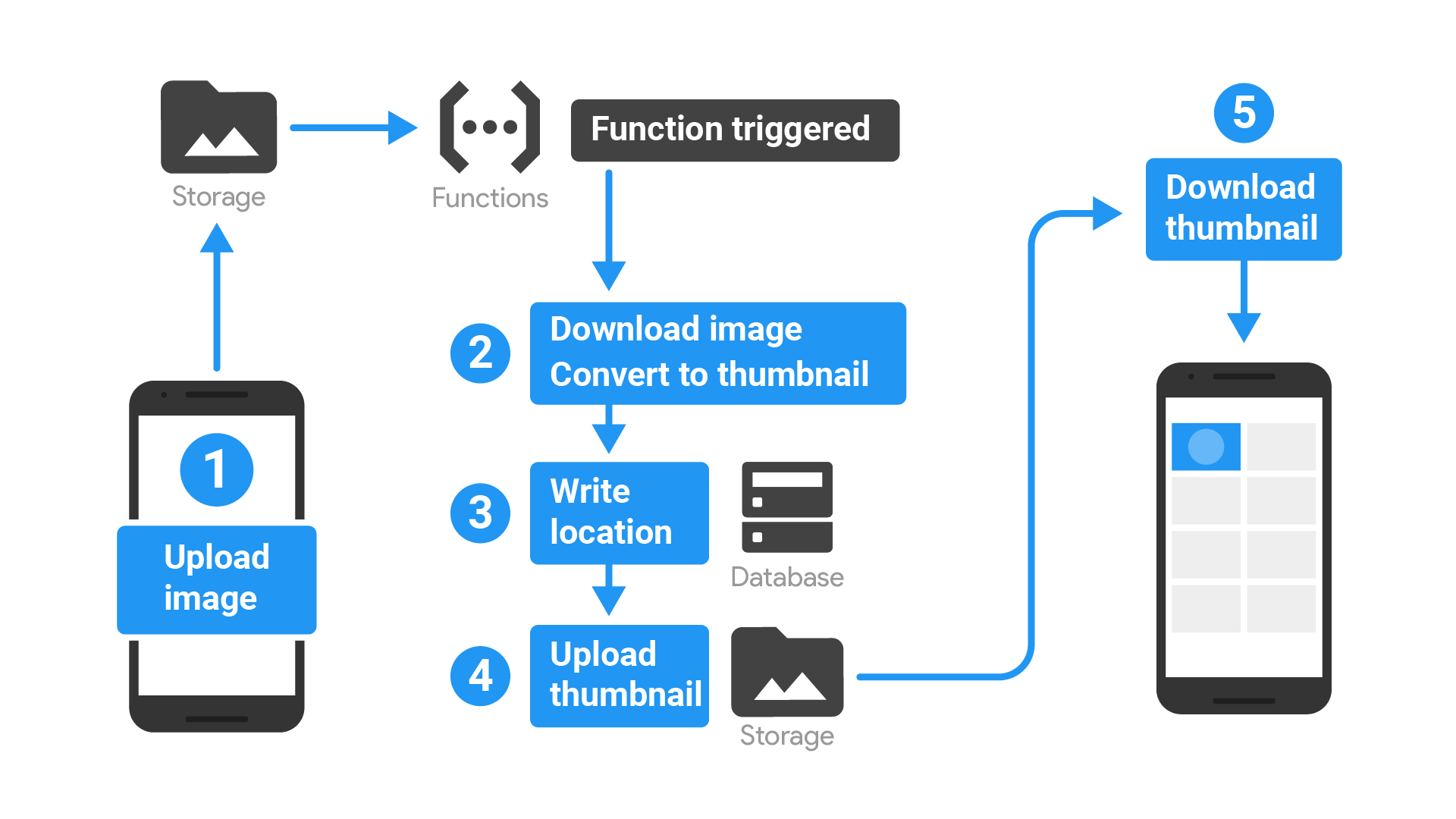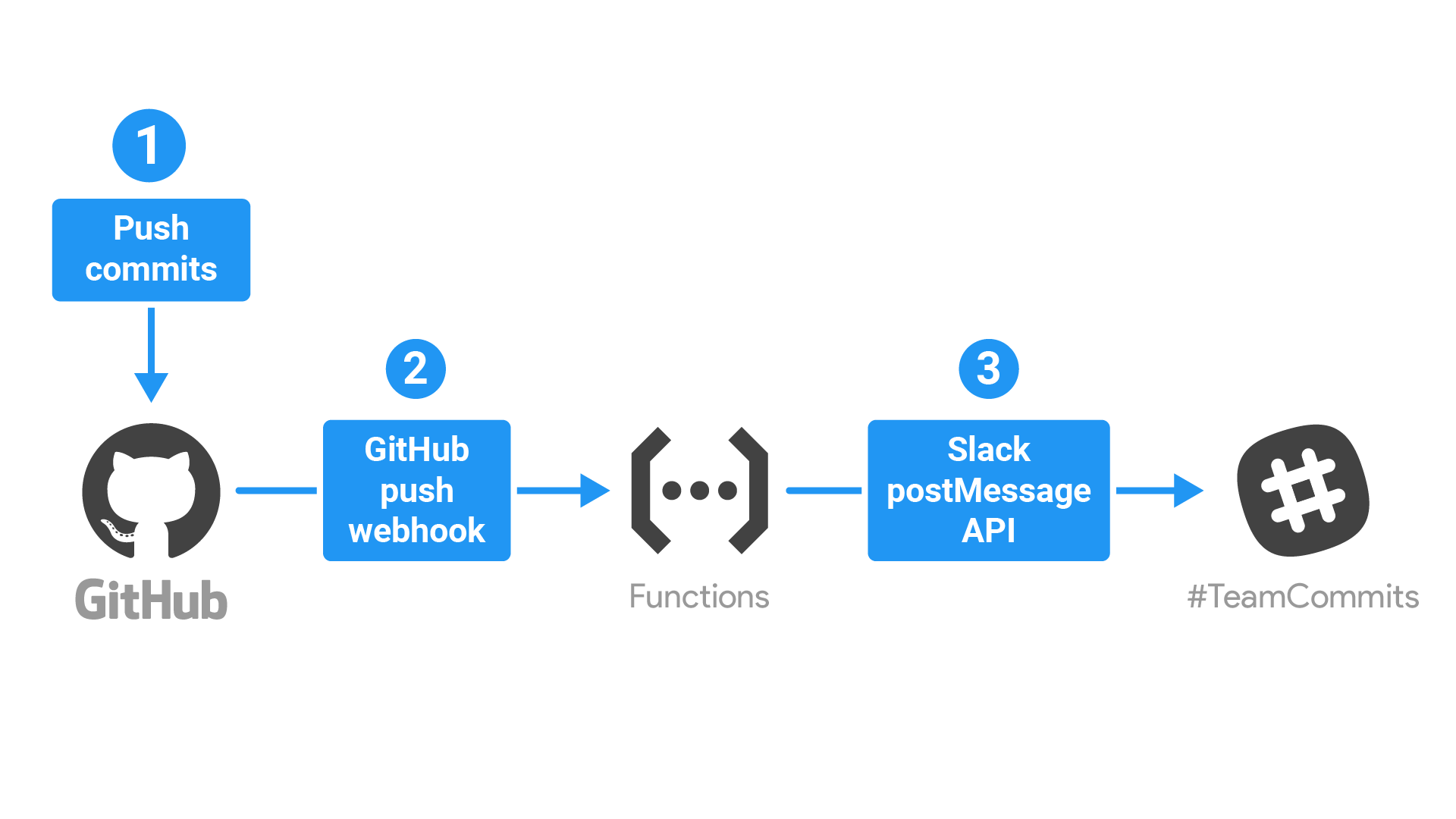Cloud Functions可讓開發人員存取 Firebase 和Google Cloud事件,以及可擴充的運算能力,以便因應這些事件執行程式碼。雖然 Firebase 應用程式預期會以獨特方式使用 Cloud Functions,以滿足獨特需求,但一般用途可能屬於下列領域:
請先查看感興趣類別的使用案例和範例,然後前往「開始使用」教學課程,或參閱驗證事件、數據分析事件等特定操作指南。
在發生有趣事件時通知使用者
開發人員可以運用 Cloud Functions 讓使用者持續參與,並隨時掌握應用程式的相關資訊。舉例來說,假設應用程式允許使用者追蹤彼此的活動,每當使用者追蹤其他使用者時,Realtime Database 中就會發生寫入作業。接著,這項寫入事件可能會觸發函式,建立 Firebase Cloud Messaging (FCM) 通知,讓適當的使用者知道自己獲得了新追蹤者。

- 函式會在寫入 Realtime Database 路徑時觸發,該路徑用於儲存追蹤者。
- 這個函式會撰寫訊息,並透過 FCM 傳送。
- FCM 將通知訊息傳送至使用者的裝置。
如要查看可運作的程式碼,請參閱 GitHub 中的程式碼範例:
- Node.js:fcm-notifications
- Python:fcm-notifications
其他有趣的通知使用情境
- 傳送確認電子郵件給訂閱電子報的使用者。
- 使用者完成註冊時,傳送歡迎電子郵件。
- 使用者建立新帳戶時,傳送簡訊確認訊息。
執行資料庫清除和維護作業
透過 Cloud Functions 資料庫事件處理,您可以根據使用者行為修改 Realtime Database 或 Cloud Firestore,讓系統維持在所需狀態。舉例來說,您可以監控寫入事件,並變更使用者訊息中特定字串的格式 (例如改為全大寫)。運作方式如下:

- 函式的資料庫事件處理常式會監聽特定路徑的寫入事件,並擷取包含訊息文字的事件資料。
- 這項函式會處理文字,將字串變更為大寫。
- 函式會將更新後的文字寫回資料庫。
如要查看可運作的程式碼,請參閱 GitHub 中的程式碼範例:
- Node.js:uppercase-rtdb
- Python:uppercase-rtdb
其他資料庫清除和維護用途
- 從 Realtime Database 清除已刪除使用者的內容。
- 限制 Firebase 資料庫中的子節點數量。
- 追蹤 Realtime Database 清單中的元素數量。
- 將資料從 Realtime Database 複製到 Google Cloud BigQuery。
- 將文字轉換成表情符號。
- 管理資料庫記錄的計算中繼資料。
在雲端執行耗用大量資源的工作,而非在應用程式中執行
您可以利用 Cloud Functions 將耗用大量資源的工作 (CPU 或網路負載過重) 卸載至 Google 雲端,不必在使用者裝置上執行,進而提升應用程式的回應速度。舉例來說,您可以編寫函式,監聽上傳至 Cloud Storage 的圖片、將圖片下載至執行函式的執行個體、修改圖片,然後將圖片上傳回 Cloud Storage。修改內容可能包括使用 sharp 或 Pillow 等工具調整大小、裁剪或轉換圖片。

- 圖片檔案上傳至 Cloud Storage 時,系統會觸發函式。
- 這個函式會下載圖片,並建立縮圖版本。
- 這個函式會將縮圖位置寫入資料庫,以便用戶端應用程式尋找及使用。
- 這項函式會將縮圖上傳回 Cloud Storage 的新位置。
- 應用程式會下載縮圖連結。
如需圖片處理範例的逐步說明,請參閱處理 Cloud Storage 事件指南。
Firebase 雲端中的其他批次工作範例
- 定期刪除未使用的 Firebase 帳戶 Node.js | Python。
- 自動備份上傳的圖片 Node.js | Python。
- 傳送大量電子郵件給使用者。
- 定期彙整及摘要資料。
- 處理待處理工作的佇列。
與第三方服務和 API 整合
Cloud Functions 可呼叫及公開 Web API,協助應用程式與其他服務搭配運作。舉例來說,用於開發協作的應用程式可以將 GitHub 提交內容發布至工作群組聊天室。

- 使用者將修訂版本推送至 GitHub 存放區。
- HTTPS 函式會透過 GitHub Webhook API 觸發。
- 這個函式會將提交通知傳送至團隊的 Slack 頻道。
與第三方服務和 API 整合的其他方式
- 使用 Google Cloud Vision API 分析及標記上傳的圖片。
- 使用 Google 翻譯服務翻譯訊息。
- 使用自訂驗證登入使用者。
- 在 Realtime Database 寫入時,向 Webhook 傳送要求。
- 啟用 Realtime Database 元素的全文搜尋功能。
- 處理使用者的款項。
- 建立電話和簡訊的自動回覆。
- 使用 Google 助理建立聊天機器人。

